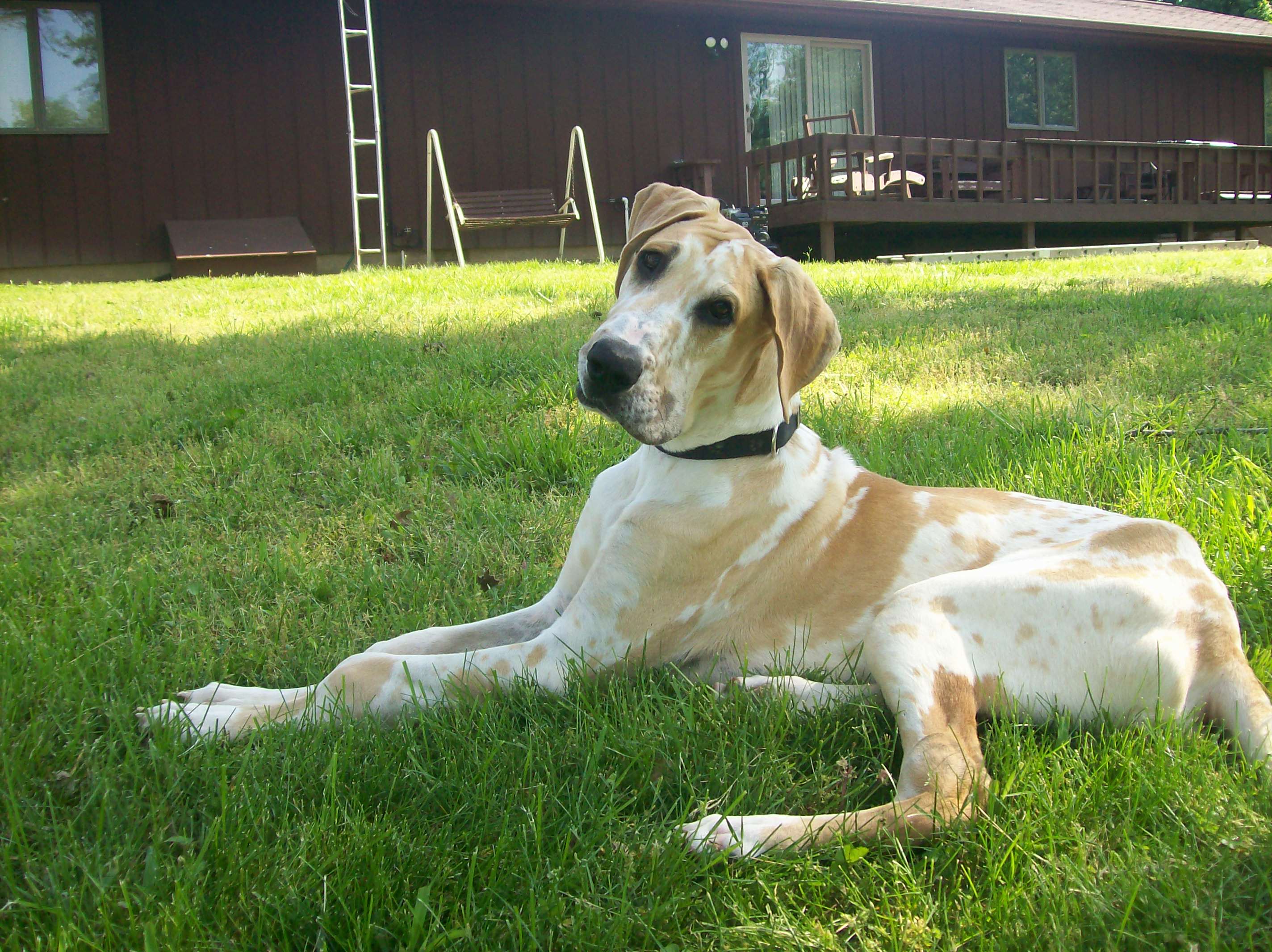Image is copyright free from Wikimedia Commons
Click "read more" to see the answer...
This is, in fact, a fawnequin Great Dane. Fawnequin is fawn + merle + the harlequin modifier, and in the case of Danes "fawn" is always a clear sable, nearly always with a mask. If you look closely (clicking the image will in fact bring up a larger version), he does in fact have black hairs on his muzzle and over his eyes. Since a recessive red will never have that, he must be an AyAy sable. I do not know of the presence of any other alleles on the A ("agouti") locus in this breed, so it is pretty safe to assume that he is in fact homozygous dominant for the sable gene. Again, since there is still seems some uncertainty as to what exactly causes variation in the shade of red of a dog, I will not be going into it (I will be doing more research on this and may include it in the future).
Because of the presence of a mask on this dog, he must have a copy of the masking gene. There can occasionally be a Dane without a mask, but the recessive red (e) gene is most likely not present in the breed. Thus, this dog is either homozygous or heterozygous EmEm or EmE masked, but is most likely EmEm.
This dog has far too much color coverage to be homozygous merle, so he has to be a heterozygous Mm merle. Good thing, too, because dogs homozygous for the dominant merle gene have an exceptionally high incidence of blindness and/or deafness.
The harlequin modifier is a special gene that, as far as I know, is rarely if ever seen outside of this breed. Merle causes a lightening of patches of a dog's fur, and harlequin takes those light patches and turns them white. Research has shown that harlequin is a dominant gene that is lethal in the homozygous state, so this dog must be a heterozygous Hh harlequin.
As for white spotting, there are three genes that can be found in the Great Dane: S or solid coloring, si or Irish white, and sp or piebald white. This dog does appear to have four white paws and possibly a white patch down his chest. For this, it is most likely that he is either sisi Irish white spotting, Ssi solid carrying Irish white, or Ssp solid carrying piebald. Since there is white on all fours paws, it is unlikely that it is due to the harlequin gene, but it is still difficult to say. Seeing him in a standing position would help with determining what sort of white spotting he has. I believe him to be Ssi.
So, that's AyAy EmEm Mm Hh Ssi, or masked sable merle harlequin with residual white (fawnequin).
So, that's AyAy EmEm Mm Hh Ssi, or masked sable merle harlequin with residual white (fawnequin).
Props to Saz, who came very close to guessing it right! For the next GtG, I plan to add the answer to the post in a format like this, so that you guys can guess, but get my opinion on the matter right away. Don't be afraid to still include your guesses in a comment as I would love to see your opinions. I could very well be wrong, mind you. That's the fun of it!


Hrmmm. Well, it's obviously a fawnquin, so I'm going to say that it's a light gold harlequin with white Irish. The color extends over the neck and onto the bottom of the legs, so that's where I get Irish.
ReplyDeleteSo that's...cchce ee Mm Hh sisi
So close, but not quite! I've posted my opinion as an edit (click "read more"). Thanks for the guess, Saz.
ReplyDeleteThe easiest way to clarify which modifier of the agouti gene is to look at them when they are puppies. Ay has real clear sabling markings, like these Finnish Spitz puppies, when they are little.
ReplyDeleteThat is very true, but part of the fun of this is looking at an adult without knowledge of what they looked like as puppies.
ReplyDelete